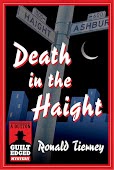O wad some Power the giftie gie us
To see oursels as ithers see us!
— Robert Burns
There’s
likely more distance than we realize between who we are, who we think we are
and who others think we are. And perhaps the latter suggests as many different
versions of us as the number of people we come across in our lives.
I
believe this is a blessing, a challenge and a hazard for writers as it no doubt
is for the rest of the population should we choose to think about it. But for writers, this should be, I think, a
consideration when creating characters and having them live and interact during
the unfolding and closing of the story.
We have a writer, a reader, a character and how the other characters perceive
that character — both physically and emotionally.
 My
older brother, whom I’ve mentioned before, frequently quotes the above lines
from Robert Burns when he senses I’ve said or done something that indicates I
must have no idea how I am perceived by others. He says this in Scottish dialect and with a
roll of the eyeballs. I suspect he’s right, but that doesn’t reduce my level of
irritation. What I see is that what I am often accused of — pomposity — runs in
the family. I don’t feel pompous and I
have friends who either don’t believe I am or are saints to overlook it. As much as anything, I suspect, I look
pompous. And this colors everything I say.
My
older brother, whom I’ve mentioned before, frequently quotes the above lines
from Robert Burns when he senses I’ve said or done something that indicates I
must have no idea how I am perceived by others. He says this in Scottish dialect and with a
roll of the eyeballs. I suspect he’s right, but that doesn’t reduce my level of
irritation. What I see is that what I am often accused of — pomposity — runs in
the family. I don’t feel pompous and I
have friends who either don’t believe I am or are saints to overlook it. As much as anything, I suspect, I look
pompous. And this colors everything I say.
This
I know. Physically, I’m tall, heavy-set.
(I’m trying to avoid the “f”
word.) I have a big
head. A famous San Francisco hatter told me when I entered her store not to
bother. “We don’t have hats for heads that big,” Also, I stand pretty straight
for an elderly man. I’ve often been told that I am intimidating, which always surprises me. I usually tell them that I wished I’d known
that when I was younger, when I could have put such a quality to good use. It’s too late, now. An intimidating old man
is simply regarded as crazy.
 This
combination of unintended intimidation and unrecognized pomposity explains some
strange events in my life. But it is a greater challenge to keep all this in
mind when you juggle a half-dozen or more characters in a novel. I’m not so
sure life is a box of chocolates. It’s
more like a box of onions.
This
combination of unintended intimidation and unrecognized pomposity explains some
strange events in my life. But it is a greater challenge to keep all this in
mind when you juggle a half-dozen or more characters in a novel. I’m not so
sure life is a box of chocolates. It’s
more like a box of onions.
Lately,
I’ve been focusing on writing novellas. This form not only means a shorter time
in which to frame a story, it pretty much also demands that the writer limit
the cast of characters, though, blessedly, not necessarily their characterization.
So this is where I spend my time and thought. For me, because my stories, long
or short, are character driven, this shorter form has allowed me to focus on
the potential subtleties of at least some of the characters. As in life, some never really bare
themselves. When they do, the revelation
may be just as dramatic as a plot twist. The three distinctions of who
can help us create multi-dimensional characters who can propel the plot and
twists thereof.
At
the moment I’m working on the third novella in a new series of novellas. The
first is in the pipeline. The second is
completed. I’m working on the third. In 2015, I expect to have a new novel and a
new novella to promote. Meanwhile, if you’re interested in checking out my
novellas here are two relatively recent ones, Death in The Haight, published by Penguin and only available as an
e-book, and the unpredictably popular Mascara,
Death in The Tenderloin, published by Life, Death and Fog Books, available
in trade paperback and e-book. Both
feature San Francisco private eye Noah Lang and his partner in detection, the
funny, gender-bending Thanh. Identity plays a significant role in both
mysteries.

No comments:
Post a Comment